
Pieter de Hooch stands as one of the most significant figures of the Dutch Golden Age of painting, a period of extraordinary artistic flourishing in the 17th-century Netherlands. Renowned primarily for his tranquil and meticulously rendered domestic interiors and courtyard scenes, De Hooch possessed a remarkable sensitivity to the effects of light and an innovative approach to spatial composition. Working alongside contemporaries like Johannes Vermeer, he captured the quietude and order of Dutch burgher life, leaving behind a body of work that continues to fascinate viewers with its warmth, intimacy, and technical brilliance. Though his fame has sometimes been overshadowed by Vermeer's, De Hooch's contribution to genre painting and his mastery of atmosphere secure his place as a pivotal artist of his era.
Early Life and Artistic Formation
Pieter de Hooch entered the world in Rotterdam, baptized on December 20, 1629. His background was modest; his father, Hendrick Hendrickszoon de Hooch, was a master bricklayer, and his mother, Annetje Pieters, worked as a midwife. This connection to craftsmanship and the practicalities of building may have subtly influenced his later keen eye for architectural detail and spatial construction in his paintings. While concrete details about his earliest artistic training remain scarce, art historians propose potential mentors.
It is believed that De Hooch may have initially studied under Ludolf de Jongh, a Rotterdam-based painter known for his portraits and genre scenes, particularly those involving soldiers and taverns. Some of De Hooch's earliest works, depicting guardroom interiors and merry companies, certainly echo De Jongh's themes. Another possibility is that he spent time in Haarlem studying with Nicolaes Berchem, a celebrated painter of Italianate landscapes, although the stylistic connection here is less direct. Regardless of his specific teachers, De Hooch absorbed the prevailing trends of Dutch art, developing a foundation in technique and composition that he would soon refine in his own distinctive manner.
The Delft Period: A Flourishing Career
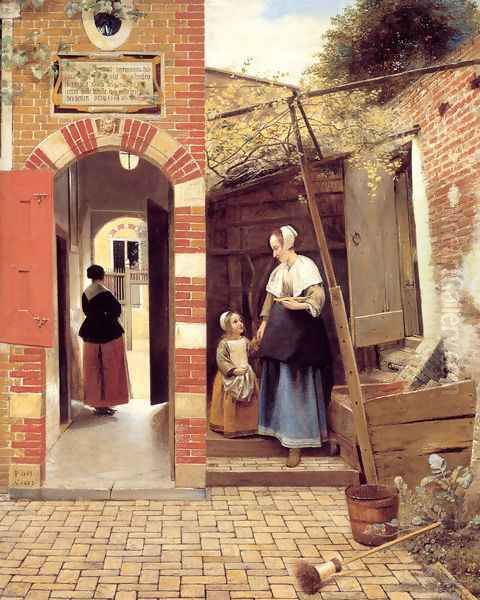
Around 1652, Pieter de Hooch relocated to Delft, a city rapidly becoming a major center for artistic innovation. This move marked a crucial turning point in his life and career. Shortly after arriving, he entered the service of Justus de la Grange, a wealthy linen merchant and art collector. The exact nature of their arrangement is described in documents as De Hooch being a "servant" as well as a "painter," suggesting a form of patronage common at the time, possibly involving board and lodging in exchange for artworks. La Grange was clearly an admirer; an inventory of his possessions in 1655 listed eleven paintings by De Hooch, indicating a productive relationship.
In 1654, De Hooch married Jannetje van der Burch in Delft. Jannetje was the daughter of Hendrick van der Burch, himself a painter of genre scenes, suggesting De Hooch was moving within artistic circles. The couple would go on to have seven children. This period of settling into domestic life seems to coincide with a significant shift in De Hooch's subject matter. He moved away from the earlier, somewhat coarser soldier and tavern scenes towards the refined depictions of middle-class homes, courtyards, and family life for which he is best known.
His growing reputation and professional standing were solidified in 1655 when he was accepted as a master painter into the prestigious Delft Guild of Saint Luke. Membership in the guild was essential for artists wishing to sell their work independently and take on pupils. This decade in Delft represents the pinnacle of De Hooch's artistic achievement, a time when he produced his most celebrated and characteristic paintings, exploring themes of domestic harmony, motherhood, and the quiet beauty of everyday existence.
Master of Light and Space: Stylistic Hallmarks
Pieter de Hooch's genius lies particularly in his sophisticated manipulation of light and space within his compositions. He developed a distinctive approach to depicting interiors and courtyards, creating scenes that feel both intimately observed and masterfully constructed. His handling of perspective is often complex, employing linear perspective to create convincing depth, drawing the viewer's eye through rooms and into adjacent spaces or outdoor areas. Tiled floors, beamed ceilings, and carefully placed furniture all contribute to this sense of structured, believable space.
Perhaps his most famous innovation is the "doorkijkje," or "through-view." De Hooch frequently composed his scenes with views through open doorways or windows, linking interior spaces with exterior ones, or connecting multiple rooms within a house. This technique not only enhanced the illusion of depth but also added layers of narrative interest, suggesting a world beyond the immediate focus of the painting. It created a dynamic interplay between inside and outside, light and shadow, enclosure and openness.
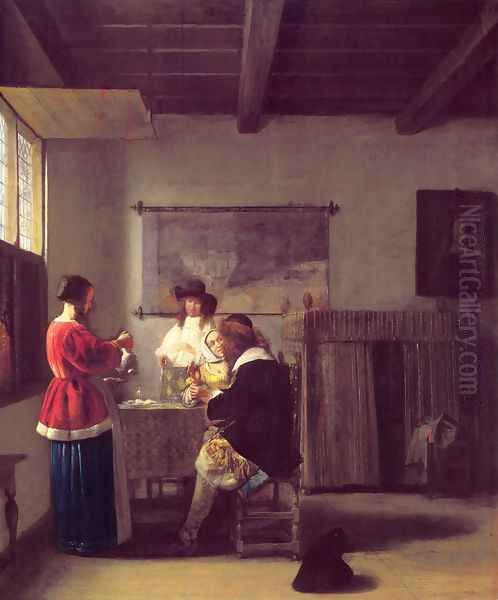
Light, in De Hooch's Delft period works, is typically warm, clear, and naturalistic. He excelled at capturing the way sunlight streams through a window, illuminates a tiled floor, or catches the texture of brickwork in a courtyard. This light is rarely dramatic but rather serves to unify the composition, create atmosphere, and highlight specific details or figures. His color palette during this time often features warm reds, yellows, golds, and earthy browns, contributing to the overall feeling of comfort, order, and tranquility that pervades his best work. He paid meticulous attention to rendering textures – the gleam of polished wood, the roughness of brick, the crispness of linen – adding to the tactile realism of his scenes.
Iconic Works: A Closer Look
Among De Hooch's most celebrated paintings is The Courtyard of a House in Delft, created around 1658 and now housed in the National Gallery, London. This work exemplifies many of his signature strengths. It presents a serene view into a brick-paved courtyard, where a woman and a child stand near an open doorway leading into the house, while another woman tends to domestic tasks further back. A passage to the right offers a glimpse of a sunlit street beyond. The composition is a masterclass in spatial layering, using the architecture to frame successive views. The warm sunlight illuminates the scene, highlighting the textures of the brickwork and tiles, and creating a palpable sense of peaceful domesticity.
Another key work is A Woman Preparing Bread and Butter for a Boy (c. 1660-1663), located in the Getty Museum. This painting focuses on a tender moment between a mother and child in a simple, well-lit interior. Light streams in from a high window on the left, illuminating the figures and the humble details of the room – the tiled floor, the wooden chair, the simple meal being prepared. The open door provides a characteristic "doorkijkje" into another room, adding depth. The painting radiates maternal care and the quiet virtues of household life, themes central to De Hooch's Delft oeuvre.
The Visit (c. 1657) showcases De Hooch's ability to handle more complex figure arrangements within an interior setting. It depicts a social interaction, likely a courtship scene, in a well-appointed room. Again, light plays a crucial role, entering from windows on the left and illuminating the figures and rich furnishings. The careful arrangement of figures, the detailed rendering of fabrics and objects, and the overall sense of calm social propriety are typical of his Delft style. Other important works like The Linen Cupboard (1663) and A Woman Drinking with Two Men (c. 1658) further demonstrate his skill in capturing the nuances of Dutch domestic and social life through meticulously constructed compositions and sensitive light effects.
The Amsterdam Years: Evolution and Challenges
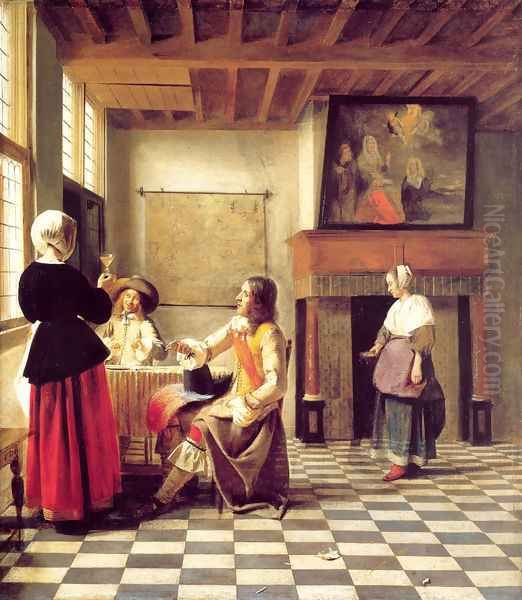
Around 1660 or 1661, Pieter de Hooch relocated his family to Amsterdam, the bustling commercial and cultural heart of the Netherlands. This move likely reflected a desire to tap into a larger and potentially wealthier clientele. His work during the Amsterdam period underwent noticeable changes, though he continued to specialize in genre scenes. The settings often became grander and more opulent, depicting the interiors of affluent merchant houses rather than the more modest Delft homes.
His color palette sometimes shifted, becoming darker and employing stronger contrasts of light and shadow compared to the luminous clarity of his Delft works. While some paintings from this era retain his earlier sensitivity, critics generally agree that the overall quality of his output became less consistent. Some later works can appear stiffer in execution, the figures less naturally integrated into their surroundings, and the handling of paint less refined. This perceived decline has been attributed to various factors.
Personal hardships may have played a role. De Hooch's wife, Jannetje, died in 1667, leaving him to care for their young children. Records indicate that his son Pieter, who sometimes appeared in his father's paintings, was later confined to an asylum in 1672. De Hooch himself seems to have faced financial difficulties and possibly declining health in his later years. The demands of the Amsterdam market, perhaps favoring more ostentatious displays of wealth, might also have influenced his stylistic evolution away from the intimate charm of his Delft period. His final years are shrouded in some obscurity, culminating in his death in 1684.
De Hooch and His Contemporaries
Pieter de Hooch worked during a period rich with artistic talent, and his career intersected with many other prominent painters. His relationship with Johannes Vermeer (Painter 3) is perhaps the most discussed. Both artists were active in Delft during the 1650s, members of the same guild, and focused on similar subject matter – light-filled domestic interiors. Stylistic similarities are undeniable, particularly in their shared interest in perspective, light effects, and tranquil moods. For many years, art historians debated the direction of influence.
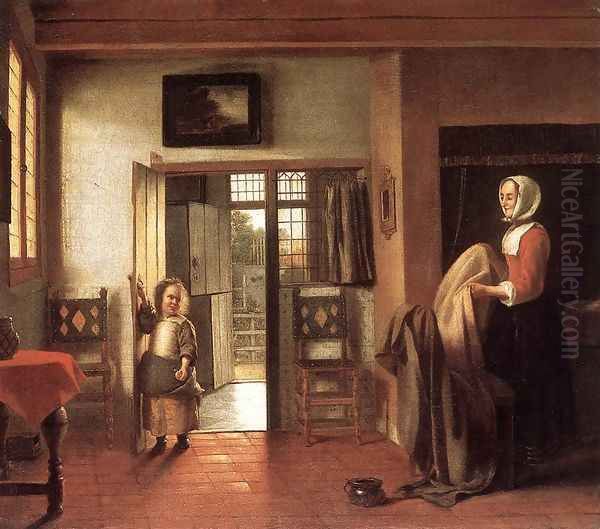
Current consensus, supported by scholars like Walter Liedtke, suggests that De Hooch was likely the innovator in certain respects, particularly in developing complex spatial arrangements and the "doorkijkje" motif, and that Vermeer absorbed some of these ideas in the late 1650s. However, Vermeer ultimately developed these elements with a unique sensibility, achieving an unparalleled mastery of light, color harmony, and enigmatic stillness that surpassed De Hooch's work in the eyes of many later critics. Their relationship was likely one of mutual awareness and perhaps subtle exchange within the close-knit Delft artistic community.
De Hooch was also connected to other Delft painters. Carel Fabritius (Painter 4), a brilliant pupil of Rembrandt who tragically died in the Delft gunpowder explosion of 1654, was exploring innovative perspective and light effects that may have influenced both De Hooch and Vermeer. Nicolaes Maes (Painter 5), another Rembrandt pupil, painted intimate domestic scenes in the early 1650s that share thematic ground with De Hooch's work before Maes turned primarily to portraiture.
Beyond Delft, De Hooch's work can be compared and contrasted with other leading genre painters of the Dutch Golden Age. Gerard ter Borch (Painter 6) specialized in elegant, high-life interior scenes rendered with exquisite attention to fabrics. Jan Steen (Painter 7), known for his lively, often humorous and chaotic depictions of peasant life and bourgeois households, offered a different, more narrative and moralizing take on genre painting. Gabriel Metsu (Painter 8), active in Leiden and later Amsterdam, created refined and detailed genre scenes that often share a similar quietude and focus on domesticity with De Hooch. Gerrit Dou (Painter 9), the founder of the Leiden 'fijnschilders' (fine painters), was renowned for his highly polished, minutely detailed small-scale works. De Hooch's potential teachers, Ludolf de Jongh (Painter 2) and Nicolaes Berchem (Painter 10), represent earlier influences. His style, in turn, influenced later painters like his father-in-law Hendrick van der Burch (Painter 1), Pieter Janssens Elinga (Painter 11), and Esaias Boursse (Painter 12), who adopted similar themes and compositional devices.
Anecdotes and Unanswered Questions
Despite his significance, Pieter de Hooch's life remains relatively sparsely documented compared to some of his contemporaries, leaving room for speculation and unanswered questions. His relationship with the patron Justus de la Grange offers a glimpse into the economic realities for artists; the arrangement where De Hooch acted as both painter and servant highlights the varied ways artists supported themselves. The inventory listing eleven of his works underscores his productivity during his early Delft years.
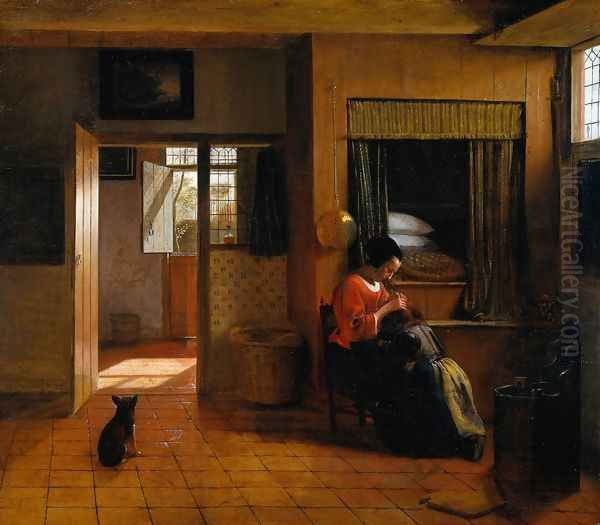
His family life, while we know the basic facts of his marriage to Jannetje van der Burch and the birth of seven children, remains largely private. The impact of his wife's death and his son's institutionalization on his later life and work can only be surmised. The rediscovery of early works, such as Backgammon Players and A Seated Soldier with a Standing Woman, found in Tel Aviv, has helped art historians better understand his artistic development before his move to Delft, confirming his initial focus on guardroom and tavern scenes influenced by painters like Ludolf de Jongh.
The circumstances surrounding his death are particularly unclear. While the year 1684 is generally accepted, the exact date is disputed, with some sources citing March 24th and others suggesting later in the year. More poignantly, records indicate that he died in the dolhuis, an asylum for the insane in Amsterdam. This suggests a potentially tragic end, possibly linked to mental health issues that may also have contributed to the perceived decline in his later work. The precise nature of his illness and the conditions of his final days remain unknown, adding a layer of pathos to the biography of an artist celebrated for depicting scenes of domestic peace and order.
Legacy and Historical Reputation
Pieter de Hooch's reputation has fluctuated over the centuries. In his own time and in the 18th century, he was highly regarded as a master of perspective, light, and the depiction of Dutch interiors, often mentioned in the same breath as Vermeer. His innovative "doorkijkje" technique was recognized as a significant contribution to the repertoire of genre painting. His Delft period works, in particular, were praised for their clarity, warmth, and harmonious compositions.
During the 19th and early 20th centuries, as Vermeer's star rose dramatically following his rediscovery by critics like Théophile Thoré-Bürger, De Hooch's reputation sometimes suffered by comparison. His Amsterdam period works were often criticized as being less inspired, coarser in execution, and overly focused on depicting wealth rather than the intimate charm of his earlier paintings. He came to be seen by some as a talented precursor or contemporary of Vermeer, rather than an equal master in his own right.

However, modern art history has brought a more balanced reassessment of De Hooch's achievements. While acknowledging the uneven quality of some later works, scholars now emphasize his crucial role within the Delft school and his significant influence on the development of genre painting. His mastery of complex spatial arrangements, his sensitive rendering of light and atmosphere, and his insightful portrayal of 17th-century Dutch domestic life are widely recognized. He is celebrated for capturing the values of cleanliness, order, and quiet industry that were central to the Dutch burgher identity. His influence on painters like Pieter Janssens Elinga and Hendrick van der Burch is also acknowledged. Though perhaps not possessing the universal name recognition of Vermeer or Rembrandt, Pieter de Hooch remains an indispensable figure for understanding the richness and variety of Dutch Golden Age art.
Conclusion
Pieter de Hooch carved a unique niche within the bustling art world of the Dutch Golden Age. As a masterful painter of light, space, and the quiet rhythms of everyday life, he transformed the genre scene into a vehicle for exploring complex compositions and subtle atmospheres. From the sunlit courtyards and orderly interiors of Delft to the more opulent settings of Amsterdam, his work provides an invaluable window into 17th-century Dutch society. His innovative use of perspective and the "doorkijkje" technique expanded the possibilities of pictorial space, while his sensitive handling of light created scenes of enduring warmth and tranquility. Though his later career faced challenges and his historical reputation has ebbed and flowed, Pieter de Hooch's finest paintings remain compelling testaments to his skill and vision, securing his legacy as a key interpreter of the Dutch domestic world and a true master of his craft.